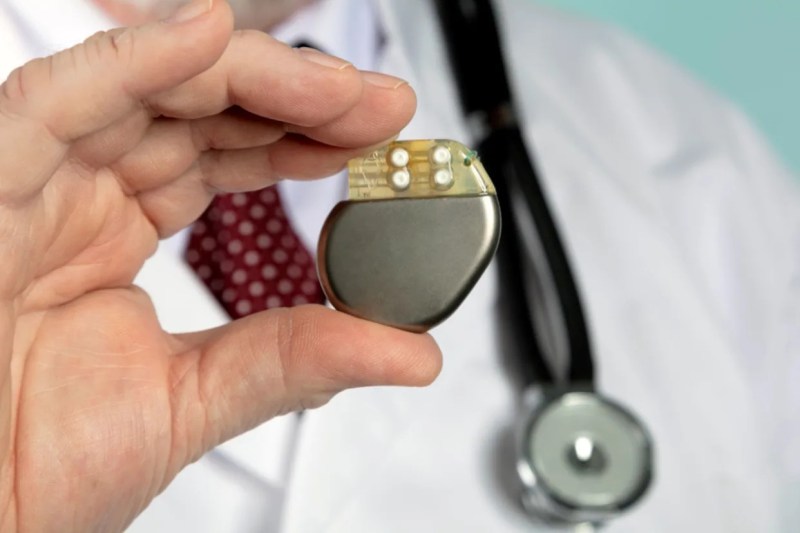Battery technology is the major limiting factor for the large-scale adoption of electric vehicles and grid-level energy storage. Marginal improvements have been made for lithium cells in the past decade but the technology has arguably been fairly stagnant, at least on massive industrial scales. At smaller levels there have been some more outside-of-the-box developments for things like embedded systems and, at least in the case of this battery that can recharge itself, implantable batteries for medical devices.
The tiny battery uses sodium and gold for the anode and cathode, and takes oxygen from the body to complete the chemical reaction. With a virtually unlimited supply of oxygen available to it, the battery essentially never needs to be replaced or recharged. In lab tests, it took a bit of time for the implant site to heal before there was a reliable oxygen supply, though, but once healing was complete the battery’s performance leveled off.
Currently the tiny batteries have only been tested in rats as a proof-of-concept to demonstrate the chemistry and electricity generation capabilities, but there didn’t appear to be any adverse consequences. Technology like this could be a big improvement for implanted devices like pacemakers if it can scale up, and could even help fight diseases and improve healing times. For some more background on implantable devices, [Dan Maloney] catches us up on the difficulties of building and powering replacement hearts for humans.
















@Bryan Cockfield There you go! A good opportunity has arisen for the author to be the experimental subject in this matter! Go on, we praise the pioneers!
How is jsut oxygen and no actuall energy source like sugar enough to recharge the pattery ? is it doign something like fusion /s ?
It appears to be a sodium-oxygen battery. Here’s a rundown on how they work: https://www.eng.uwo.ca/nanoenergy/publications/2020/pdf/Hossein-yadegariXueliang-Sun-2020-Trends-in-Chemistry.pdf
These are usually sealed and work by reversing the oxide/peroxide reaction. If you’re going to instead make them work by continuously replacing the peroxide battery with oxygen from the body, you need to then have some way of disposing of the peroxide ions – this remains unexplained in all the literature I can find.
I assume the body would clear the side products just fine, at least for a reasonably small dose.
Yup, the body produces hydrogen peroxide naturally anyway, and we have processes that neutralize it so it doesn’t build up and cause problems. I wonder how much can be produced by a battery like this before it would cause a problem. I also wonder if it’s possible for it to cause local problems near the battery, or if in small enough amounts, it just gets handled and doesn’t cause any problems.
And if it accidentally burst into fl@me how long to put out the patient?
So that’s why Kenny spontaneously combusted
https://www.youtube.com/watch?v=GjrwS47Z4Lc
So, uh, how many, er, “patients” would one need to, say, power a small city? Asking for a friend.
Why stop at at a small city, when you could power yourselves *and* a simulated environment to keep the “participants” entertained?
“It takes a village.”
-Hillary
The “new kind of fusion” was almost certainly mana – the machines were using human brains to repeatedly cast “lightning bolt” into the power grid. Almost nothing else could make any sense.
Is this article made from an article made from an article made from an article made from an article ? Really ?
No I think it is an article made from an article made from an article made from an article made from an article made from a scientific paper.
It’s articles all the way down.
I work in the pacemaker industry, and you typically only need a replacement every 5-8 years. Also, the implant itself eventually needs to be replaced. Electronics dont last forever. A battery that outlasts its implant is worthless. My prediction is that faced with actual medical validation, this will never leave the concept phase.
I suspect it will eventually if it proves safe and high enough power generation to be useful. As the battery that never needs charging or replacing because its failing means you only need to get medical help when the functional part reaches EOL. One less expected failure point so it is not a race between a failing battery and failing functional electronics. One trip to hospital when the implant is at that ‘eventually needs to be replaced stage’ rather than 2? 3? 4? extra trips that are effectively wasting everyone’s time if this tech means its not required.
And if the battery doesn’t degrade meaningfully and so outlasts each implant you can alter the design and methods of implants so the functional electronic parts are the only bits you need to exchange most of the time, which probably helps with recovery time etc.
It DOES NOT recharge itself. It simply burns up metal using oxygen from the body. Eventually it will be depleted.
Yeah, was wondering about that. If we had a battery that charged with just oxygen, why wouldnt almost everything have one. There seems to be oxygen around me most of the time ;). If is depleting another material, how is that different from the alkaline cell in my flashlight?